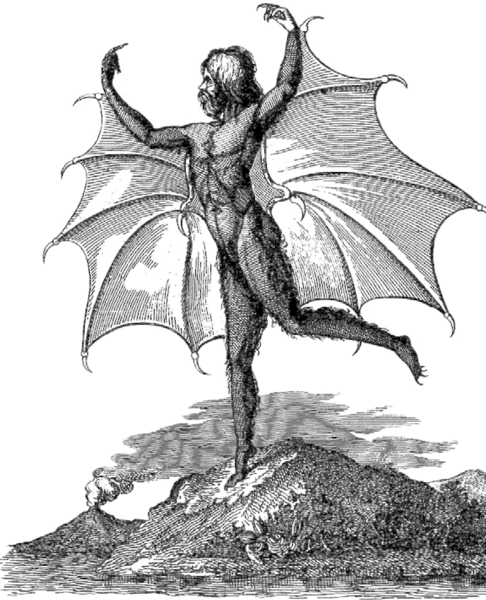 Richard Adams Locke meant for his articles in the NY Sun to be taken as satire. They were the 19th
century version of a "Saturday Night Live” skit. He was making fun of a recent
rash of dim-witted sensational claims of people who alleged to have had
experiences with extra-terrestrial beings. The problem was, when he published
the first article, everyone believed them to be true.
Richard Adams Locke meant for his articles in the NY Sun to be taken as satire. They were the 19th
century version of a "Saturday Night Live” skit. He was making fun of a recent
rash of dim-witted sensational claims of people who alleged to have had
experiences with extra-terrestrial beings. The problem was, when he published
the first article, everyone believed them to be true.
On August 25, 1835, the first of six articles appeared in
the NY Sun written under the name of Dr.
Andrew Grant – a person that Locke made up. The articles professed to be
reprinted from the Edinburgh Journal of Science and told of species of animal life on the moon. The
lunar life forms had been seen with a new powerful telescope located at the Cape
of Good Hope in southern Africa. They included winged "batmen”, unicorns, wild
bison and two-legged, tailless beavers. They all lived in a lushly vegetated
environment, replete with flowing rivers and mountains. The batmen had built
temples where they worshiped their moon god. Locke used his vivid imagination
and extreme wit to paint a utopia on the moon. With each article, more
newspapers were sold. A group of Yale students were sent to the NY
Sun to do research on the source materials.
The staff made sport of them, sending them on a wild goose chase to find the
original articles. They were told they were stored in one department of the
publisher, and then told they had been moved to another, then another. The
students never caught on that the articles were not in existence. Locke and his
editors were having a heyday. However, they had a problem. How long could they
keep this hoax alive? They hatched a plan to put an end to the lunar lunacy.
After the sixth article was published, the NY Sun announced that the telescope had been left open
during the day and the sun, reflecting down the powerful lens, magnified a
sunbeam and caught the observatory on fire, destroying the telescope. Of course
this would only be a temporary fix. In a matter of time someone caught on and the
truth got out. It was announced that there was no one named Dr. Andrew Grant.
It was discovered that the Edinburgh Journal of Science had gone belly up years before. There was an
observatory that had been built on the Cape of Good Hope, but the telescope
there did not have Hubble-like abilities to peer into the private lives of moon
creatures. The NY Sun admitted it
was all a great hoax, intended to be satire that had taken on a life of its
own.
Satire, parody and lampooning in advertising are alive and
well. Satirical video populates most of YouTube. When it works well, it is a
great device to draw attention to your product. The good thing about satire in
advertising- it is memorable. Some of the highest rated ads of all time have
been built on making fun of the competition. Take a look at this classic Apple
commercial. However,
when satire goes bad, it can be horrid. Part of the problem is that humor is in
the eye of the beholder. What one person finds funny, another person finds
distasteful. All of this toes the line of political correctness. Satire, by its
very nature, is making fun of someone. In today’s culture, that can be seen as
bullying. Brands like Hardees (remember the pregnant woman ad – you won’t find
it on YouTube anymore) have been lambasted for their sexist ads. Since 2004,
when Hardees introduced an ad with a steamy model riding a mechanical bull
eating a Thickburger, sex has been a part of the parody in their commercials.
The outcry has been loud; just do a quick search for Hardees commercials. Yet
the majority of the Hardees customers – especially those eating their
Thickburgers - are men. The advertising spots reflect a target market that
Hardees wants to own – namely blue collar young men who are eating breakfast
and lunch at fast food restaurants. The bottom line is, it may be offensive to
women, but it works on men.
Here are a couple of tips to follow if you decide to use
satire in your ads. First, define your target audience. What is funny to
21-year old males is not funny to their mothers. If you know that you are
targeting a certain demographic, find out what makes them laugh and build your
message around it. Also realize that being funny doesn’t necessarily mean that
people will remember you. Don’t get so wrapped up in making people laugh out
loud that you forget that your primary reason to make them laugh is so they
remember your brand. That gets lost in many of the YouTube videos you see. Timing
is key here. Make them laugh and then get the brand in front of them. Here is a good example of what I mean.
Jack Links Beef Jerky.
___________________________
The Great Moon Hoax,
This Day in History, History.com
Illustration public domain, published in the US before 1923 and public domain in the US.